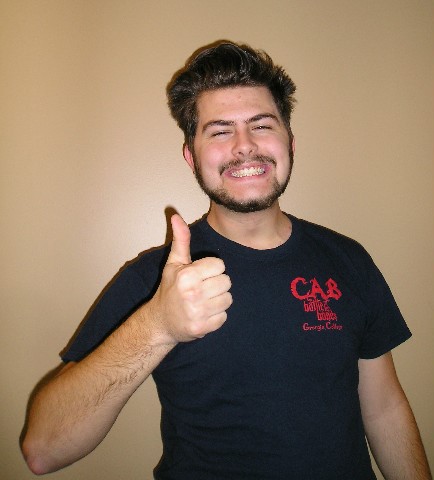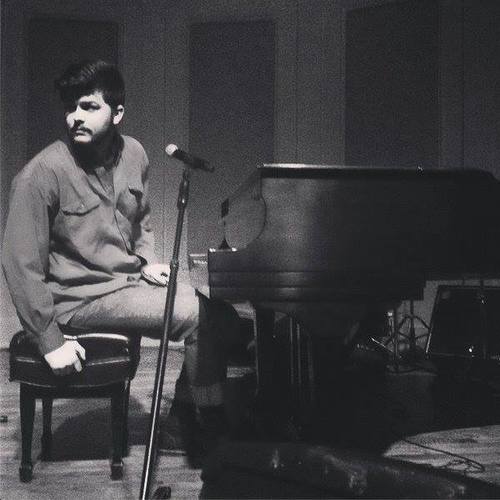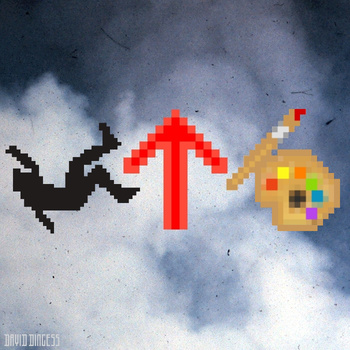David Dingess is a composer, singer and musician. He has amassed a large number of recordings, both solo and in collaboration with other artists.

Here is one of David’s albums, Fall Up Art.
Click on the cover art to go to his BandCamp site to listen to samples.

David re-created “Elmer’s Safety Song” from scratch. No original sound files of the 1964 piece have been found so David had to discover what it might have sounded like, and what instruments and effects would have been most accessible to the children for whom it was intended.
“Elmer’s Safety Song” was composed by Dolores Claman with lyrics by Richard Morris.
Listen to David’s version of “Elmer’s Safety Song” here:
Here are scans of the original sheet music, which is the only thing David had available to do his work.

David talks about his work, his art and music, and the challenges of re-creating and recording “Elmer’s Safety Song” in an exclusive interview in Ferreira Fest 60.
Here is a sound clip and transcript of the interview.
FF – Hi David, and welcome to The Friends of Louis Ferreira. We’re so thrilled to talk to you today about your recording of Elmer’s Safety Song. But first let’s get to know you a little better.
So, tell us about yourself, what you do, what your passions are and what gets you up in the morning.
DD – All right, well, first of all I love art in pretty much any way possible. It actually annoys my girlfriend to pieces because I just talk about the way things look and things like that all the time. But I also am a poor choice of Renaissance Man. I like to longboard and play pool and be good at things that most people aren’t, just because…. And I especially love sound. And that’s about it.
FF – All right! Can you tell us a little bit about your music?
DD – A lot of my influences come from experimental music, soundscapes, I like James Blake and things like that. I’m more on the cold side of music, so definitely digital, which is funny because the output of my music is all analog because I didn’t grow up with any sort of sound technology education. I just had a very classical boy choir which led to more choir which led to being a music major at school.
So I have piano and guitar and things like that in my arsenal but I really like to listen to digital music.
FF – So, you sing as well? You’re a singer as well as a musician, an instrumental musician?
DD – Yes.
FF – Okay. How did you get involved in collaborative music? And that’s mostly how I know you, as a collaborative musician. And when I say collaborative musician, I mostly talk about people who don’t do just music for music’s sake but people who compose or work on music that collaborates with other media. For example, in your capacity, as I know you, as a composer for theater and for theatrical pieces.
How did you get involved in this kind of composing and music?
DD – I used to just make the music, put it on the internet, throw up a status and let the few people who were interested have that share, which was nice. And I made a really close connection with Julie Mulvihill who was a dance professor here for a while. I took a movement class with her and I mentioned to her, one day, that I made music and she immediately gave me an opportunity to compose for a piece she was doing based off The Little Prince.
So I got to do that and that was my very first run at it, so of course it was me and my iPhone recorder on a piano and I played, I think it was a twelve minute piece. I sat there and just played things over and over for probably two or three hours.
And then that little portion of it stuck out to me.
And it just, it just fit. And because of that, when I was at the Dance Minor Concert, I had Iona (Iona Holder) come up to me, after the show and she said, “You’re composing for Death of a Salesman.”
And I said, “Okay.”
And so that’s kind of where it all started.
FF – And Death of a Salesman was kind of also special because you actually composed in a different time period. Because it’s set early in the 20th century, so definitely not the digital age, so the challenge was to compose music that would actually fit the time period.
DD – There’s a lot of like… there was a lot of research of what kind of music was going on there. And more of the slow-paced music then, because there was a lot of like ragtime jazz and things like that that would have been more accessible to Willy, but the play doesn’t necessarily call for happy music so I had to find a way to approach such a depressing play in a time where the music was so “up”.
FF – And of course you got an opportunity to work with a really good sound designer, too, who was able to manipulate, and I remember the cross-fades from it sounding period to bringing it into the 2000’s.
DD – Right. Yeah. A lot of it was help with the format or the way that it was presented was definitely altered in a more suitable way. But the composition part was mostly just sticking to the jazz chords, the circle of fifths that were going on during that time.
FF – Right. And actually that particular composition took you out of town, too.
DD – Yes. I got to be a part of National KCACTF. And I studied for a very short and, I miss it so much, but a very short week with Rob Kaplowitz who is a Tony Award winning sound designer.
FF – I bet that was a real thrill!
DD – It was. It was a thrill and a story with that was that I was his least favorite student because we went for drinks after one of the rehearsal days and I explained to him my theory on art and what should be free and what should be paid for. And I justified sound designing as a job because you’re in the midst of working when you’re a sound designer. But I said that musicians who make something and then in retrospect are still making money, unless you’re gambling on the stock market, that shouldn’t be lawful. And he was angry. And ever since then he sends me Facebook articles about justifying musicians, and I fire back, but it’s all healthy.
FF – Yeah. Well, it’s good to have that kind of exchange of ideas with other composers and musicians because there’s certainly a range of opinions about the professions out there. So that’s a good thing when that happens.
All right, let’s talk a little bit about Elmer’s Safety Song specifically, which is why you’re here today. And so, Elmer’s Safety Song is, of course, a part of a vital child safety campaign in Canada. Tell us a little bit about your process and the challenges in making this piece of sheet music come alive. Because originally I just handed you a piece of sheet of music and said, “Here, record that.”
DD – Yeah, so once I figured out what the music called for, the rest was trying to find the style and it was difficult to find style in a piece that was, quite literally, irretrievable on the vast world of the internet. There was nothing to look at that kind of reflected, like if I went and looked up Smokey the Bear, which would be sort of our American equivalent, it would give me all sorts of songs.
But I think because it was of that time and that it still isn’t carried on today, which kind of made me wonder anyways, but it doesn’t continue on and so it was hard to kind of recapture that history. So I found videos that sort of explained the job of Elmer the Safety Elephant and the statistics.
And so I wanted to capture the importance of it and make it as authentic as I possibly could because it was supposed to be approached by children and so it needed to be approached by children today.
FF – So, you recorded the song on your own studio equipment and tell us a little about that, for the tech geeks among us, as much as you know.
FF – I used Ableton Live, I was taught Ableton in high school, in a very small amount, never any formal training, so I’ve just been kind of… When I have, when I say, “I want to do this” to sound, I’ll eventually find someone with the education, or something on line that will explain to me. And so I’m just now getting a grasp of equalizers and things like that, so I’m constantly working on studio quality.
But for the equipment I had a Toneport UX1, which is their first product for recording and it’s supposed to be used for a multi-track recording for a very small ensemble, probably just one person because it has such a… yeah, it’s just got the vocal and the guitar port. But I’ve just been using that because it was the first piece of equipment that was handed to me and I’ve been using it ever since.
FF – What prompted you to make the musical choices that you made for this? Other than, you know, your research and stuff, such as the keyboard sound quality and the echo effects that you put in.
DD – I did some research on what really, really young kids find approachable. You know, watching Barney and things like that. And the timbre, the piano was there, but it wasn’t always the main instrument, so sometimes I doubled with a xylophone and things like that. It kind of sounds like things like that that can be taught in a pentatonic way so that children can see that music is very approachable.
FF – Right.
DD – And so I definitely went along with that style. The reverb, and things like that, were added because I wanted to try, it was just a one man show, but I wanted to capture that the person singing and the person, and Elmer, were, you know, two different individuals. And maybe even like that’s where he would have been on the stage.
FF – Right. So we see the rules and then we see, or, we hear the rules and we hear Elmer actually singing it, so that’s where it came from.
DD – Right.
FF – And that became very clear that they’re actually the same voice, but it’s two different people talking.
As a young professional you want to do, of course, as many different styles and take as many different opportunities that provide your work with a wide variety, but what is your favorite thing to do, musically speaking?
DD – I’m finding right now that, the great thing that I just love about, like, theater is that I have to hold all the reins with my art. I couldn’t imagine being able to let people slice and dice it. I do love to cater to something that’s bigger than me, so it’s such a great combination for me because I don’t want anyone to tamper, but at the same time, I’ll edit it all day long, myself, for you, you just tell me what you need.
So that was a great experience. But I think what I’ve enjoyed the most is, right now I’m working on a senior capstone of a friend of mine called Body Unabridged. And she’s given me all the reins to create music based on these short essays that she’s writing about how she feels about her body and different body parts and what comes to mind.
And because I love, modern dance now is a little more, it’s more free to, there’s no, it’s not required to have any rhythm or things like that within the pieces so that lets me, lets those experimental things keep churning.
One of the pieces is called Spine. And it’s a nine minute long piece but the first four minutes I recorded some celery breaking, over a microphone, and I took out all the treb, and so, and then I put a lot of reverberation. So it sounds like someone’s popping their spine.
And then I added a bunch of reverberance for ambience, so it’s constantly filling the room while this person is speaking over it.
I like going into the abstract with real footsteps turned into rhythm for the beat piece, just things like that.
FF – But what I seem to hear is that you really enjoy the collaboration with other artists, other media?
DD – Absolutely. Especially anything movement oriented.
FF – So, theater, dance, anything that’s physical, onstage that you can actually collaborate with and be a people partner.
DD – Absolutely.
FF – Rather than, oh, write a piece for that and we’ll play it sometime.
DD – And I find that some pieces, when I collaborate, some pieces, I have to watch what I’m writing for and other times it’s like, oh, and that thought gives me this, and then I can hand it off and see what… and I’ll go back to the drawing board thirty times before I’ll let them actually, even now I’m like, “Please don’t, please don’t put that song up I want to edit it right now.”
But I guess it’s, art is never done.
FF – Well, thank you so much for your time there, David. Where can we learn more and find out more about your work?
DD – I have a website at DavidDingess.com and you can find me also on Bandcamp, there’s some links through there, and on the website there’s a list of all the projects that I’ve been honored to work on, so…
FF – Thank you so much for your time, David.
DD – Thank you.
Thanks to Casey for the transcript!
David is on Twitter and on Instagram.
Please be sure to visit David’s web site at daviddingess.com, and learn more about Elmer The Safety Elephant on our Elmer Page.



